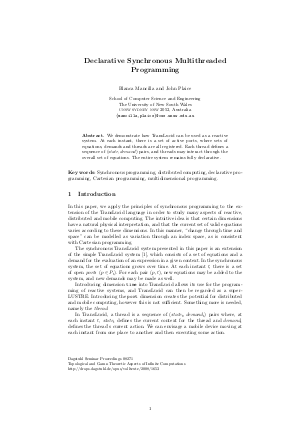Declarative Synchronous Multithreaded Programming
Authors Blanca Mancilla, John Plaice
-
Part of:
Volume:
Dagstuhl Seminar Proceedings, Volume 8271
Part of: Series: Dagstuhl Seminar Proceedings (DagSemProc) - License:
 Creative Commons Attribution 4.0 International license
Creative Commons Attribution 4.0 International license
- Publication Date: 2008-11-05
File

PDF
DagSemProc.08271.4.pdf
- Filesize: 174 kB
- 6 pages
Document Identifiers
Subject Classification
Keywords
- Synchronous programming
- distributed computing
- declarative programming
- Cartesian programming
- multidimensional programming.
Metrics
- Access Statistics
-
Total Accesses (updated on a weekly basis)
0Document
0Metadata
Abstract
We demonstrate how TransLucid can be used as a reactive system. At each instant, there is a set of active ports, where sets of equations, demands and threads are all registered. Each thread defines a sequence of (state, demand) pairs, and threads may interact through the overall set of equations. The entire system remains fully declarative.
Cite As Get BibTex
Blanca Mancilla and John Plaice. Declarative Synchronous Multithreaded Programming. In Topological and Game-Theoretic Aspects of Infinite Computations. Dagstuhl Seminar Proceedings, Volume 8271, pp. 1-6, Schloss Dagstuhl – Leibniz-Zentrum für Informatik (2008)
https://doi.org/10.4230/DagSemProc.08271.4
BibTex
@InProceedings{mancilla_et_al:DagSemProc.08271.4,
author = {Mancilla, Blanca and Plaice, John},
title = {{Declarative Synchronous Multithreaded Programming}},
booktitle = {Topological and Game-Theoretic Aspects of Infinite Computations},
pages = {1--6},
series = {Dagstuhl Seminar Proceedings (DagSemProc)},
ISSN = {1862-4405},
year = {2008},
volume = {8271},
editor = {Peter Hertling and Victor Selivanov and Wolfgang Thomas and William W. Wadge and Klaus Wagner},
publisher = {Schloss Dagstuhl -- Leibniz-Zentrum f{\"u}r Informatik},
address = {Dagstuhl, Germany},
URL = {https://drops.dagstuhl.de/entities/document/10.4230/DagSemProc.08271.4},
URN = {urn:nbn:de:0030-drops-16536},
doi = {10.4230/DagSemProc.08271.4},
annote = {Keywords: Synchronous programming, distributed computing, declarative programming, Cartesian programming, multidimensional programming.}
}
